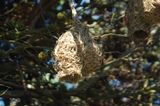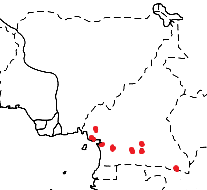Weaver species
Choose different species from drop-down list and press 'Go' button. See Full species list.Bates's Weaver Ploceus batesi
IUCN: Endangered Discovery: 105Categories: IUCN,
News items about species
Discovery
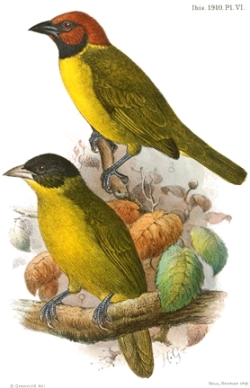
figure from Ogilvie-Grant (1910) 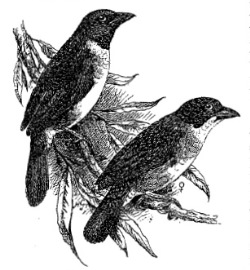
figure from Bannerman (1949) 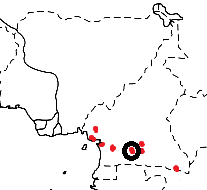
distribution, type locality circled IntroductionBates's Weaver was formally described by Richard Bowdler Sharpe, an English zoologist and ornithologist who worked as curator of the bird collection at the British Museum of natural history.Bates's Weaver was collected by George Latimer Bates, an American naturalist. Bates visited West Africa in 1895, making a living by farming. In 1905 he settled on the Ja River, Cameroon, calling his farm Bitye (after the Bulu pronunciation of his name). He collected many natural history specimens, especially birds, in his travels and sent many of these to the Natural History Museum in London. Bates obtained the type specimen of Bates's Weaver, a female in subadult plumage near the Dja River on 29 January 1906, presumably near Bitye farm (as stated by Bannerman 1949a). On 17 Nov 1908 a second specimen, the first adult male, was collected at nearby Kumangola. In the following year four more birds were collected at Bitye and sent to the British Museum. Bates did not observe these rare weavers alive; they were all collected by local boys with bows and arrows (Bates 1930a). Bates obtained the first Bates's Weaver specimen in January 1906, nearly a month before obtaining the Red-crowned Malimbe type, but Sharpe described the latter first. Bates's Weaver was first illustrated by Ogilvie-Grant (1910), showing the female type and first male specimen. The next illustration to be published was a line drawing in Bannerman (1949), showing the male and female. Scientific citationOthyphantes batesi Sharpe 1908a, Ibis p.348, Dja River, Cameroon.Meaning of namesbatesi, Named after George Latimer Bates (1863-1940), a naturalist in tropical West Africa, 1895-1931.First English nameBates's Weaver-Finch (Sharpe 1910a).Alternate namesBates's Weaver-Finch.CollectorGeorge Latimer Bates.Date collected29 January 1906.Locality collectedRiver Ja, Cameroon.Type specimensThe type is in the Brisitsh Museum (BM 1908.5.25.104). |
The above is based on Weaver Wednesday 2, a weekly series about the discovery of each weaver species.
This species text first appeared as
Weaver Wednesday [222] - Discovery [105]: Bates's Weaver on 2016-09-14
1. Basic biology
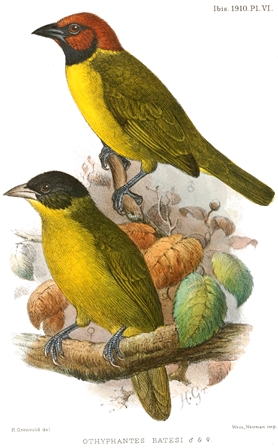
figure from Ogilvie-Grant 1910 Distribution. The Bates's Weaver is restricted to a few localities in southern Cameroon's lowland rainforest (see map below, based on Birds of Africa). There are no subspecies of the Bates's Weaver. It is listed as ENDANGERED, due to its rarity. The estimated global population is less than 1000 individuals, and it is probably declining due to habitat loss. It has been recorded only at nine sites in a narrow belt from Limbe east to Moloundou. In recent years, it has been seen on Mt Kupe (twice in 1990) but not since, in spite of intensive searches. It has been seen near the Dja reserve (at Somalomo in 1995 and at Shwani, 12 km from Somalomo, in 1996). The rarity of Bates's Weaver is a mystery; it may be due to the loss of some specific habitat feature but the species was already rare when it was discovered in 1906.
Habitat. The Bates's Weaver inhabits lowland rainforest, up to 900 m on Mt Kupe. Food. The Bates's Weaver feeds on insects. It forages singly, or in pairs, and once was seen in a mixed-species flock of insectivorous birds. It moves in a zig-zag manner up creeper-covered tree-trunks. Breeding. There is no information on the breeding biology of the Bates's Weaver and the nest and eggs are undescribed. |
The above is based on Weaver Wednesday, a weekly series about weaver species.
This species text first appeared as
Weaver Wednesday [88]: Bates's Weaver on 2014-02-19
2. Breeding facts
| Pair bond no information Breeding season Juvenile in Mar Nest site no information Nest building no information Colony size no information Clutch size no information Egg colour no information Egg size no information Incubation no information Chicks and nestling period no information |
Breeding information based on Handbook of the Birds of the World, Vol. 15.
3. Photos of Weaver Nests
No records yet - be the first to submit a PHOWN record!See PHOWN summary page for this species here.
PHOWN (Photos of Weaver Nests) provides valuable info on breeding distribution and colony sizes of weavers.
You can contribute by registering and submitting photos at Virtual Museum webpage.
4. Breeding distribution
Google map showing distribution (For species with small ranges you need to zoom in at the correct area to see the range):
yellow blob - range of weaver species; read more about this here.
![]() - PHOWN records with photos
- PHOWN records with photos
![]() - PHOWN records with no photos (Nest Record Cards, other records)
- PHOWN records with no photos (Nest Record Cards, other records)
![]() - Birdpix records
- Birdpix records
![]() - comments on out of range records, or interesting records
- comments on out of range records, or interesting records
![]() - type locality
- type locality
CLICK on the marker on the map to see individual record details.
5. Range changes
Not South African speciesThe above is based on Weaver Wednesday 3, a weekly series about range changes in South African weaver species.
This species text first appeared as
n/a








